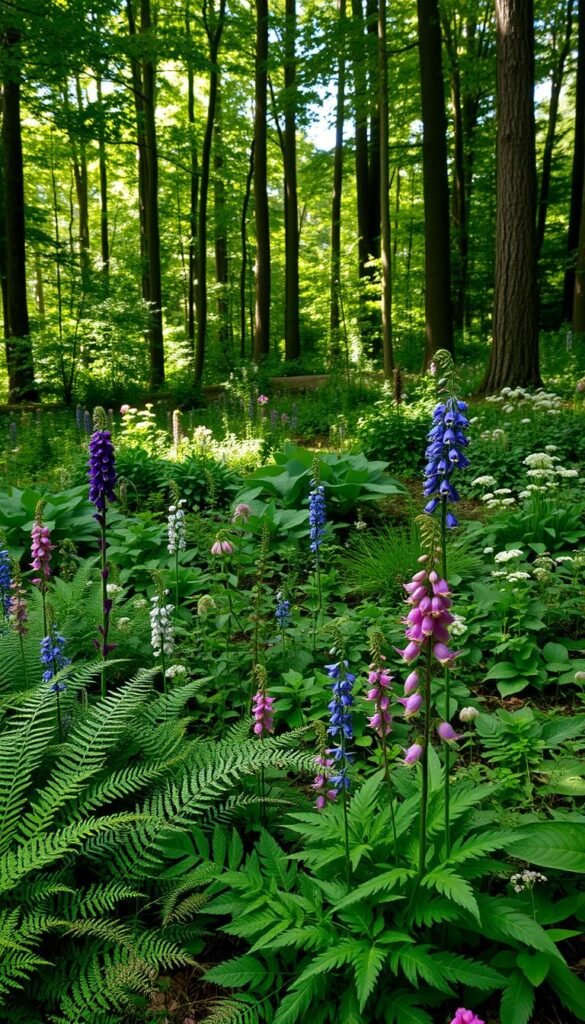Think those dim corners of your yard can’t bloom? Think again. Many stunning plants flourish without full sun, turning shadowy spots into lush retreats. These varieties evolved under forest canopies, thriving where sunlight filters through leaves rather than beating down directly.
You don’t need to settle for bare patches or sparse greenery. With the right picks, you’ll create layers of color and texture that rival sun-drenched beds. Hostas unfurl broad leaves while impatiens splash vibrant hues—both perfect for spaces with just 3–6 hours of light daily.
Starting a low-light oasis is simpler than you might expect. Many woodland natives require minimal upkeep once established, adapting naturally to cooler, moister soil. If you’re new to gardening, explore beginner-friendly options that add instant charm without demanding constant attention.
Your shaded areas can become sanctuaries for pollinators, too. Bees and butterflies visit blooms like columbine and bleeding heart, drawn to their unique shapes and nectar-rich petals. It’s not just about beauty—it’s about building ecosystems where life thrives in harmony.
Welcome to Your Shade Garden Journey
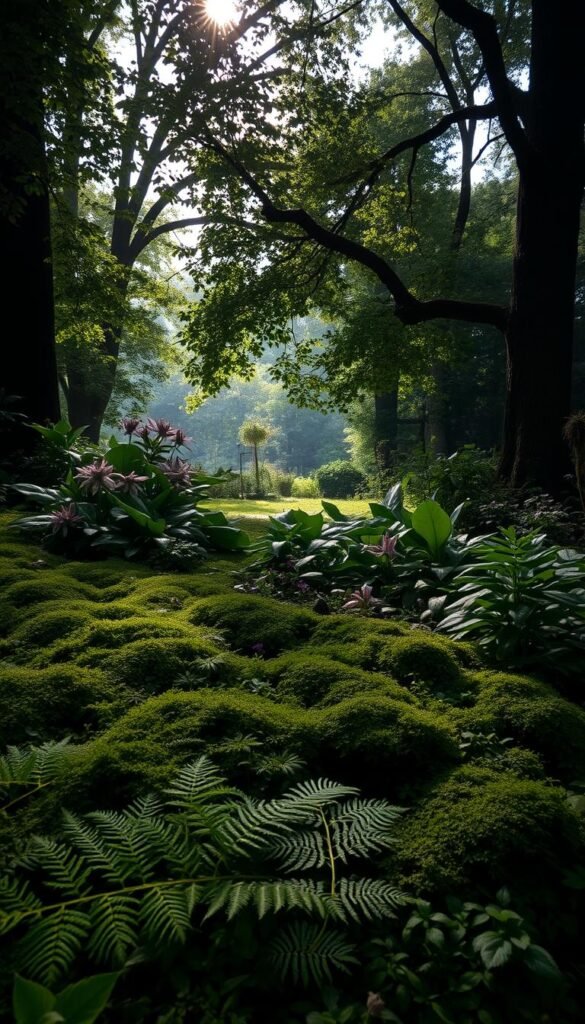
Imagine stepping into a cool, green oasis where sunlight dances through tree branches above. This isn’t a distant forest—it’s your own backyard. Shaded spaces hold untapped potential, offering a chance to grow plants that shimmer with subtle beauty.
Discover the Beauty of Low-Light Gardens
Your shaded garden areas become stages for nature’s understudies. Ferns unfurl lace-like fronds, while coral bells paint the ground with burgundy and lime streaks. These plants evolved to showcase intricate details without bright light, creating visual depth through contrasting leaf shapes.
Many woodland natives bloom longer than sun-loving varieties. Astilbe sends up feathery plumes in summer, and toad lilies surprise with orchid-like flowers in fall. You’ll find blooms that shift from soft pastels to rich jewel tones as seasons change.
How Shade Can Enhance Your Outdoor Space
Dappled light transforms gardens into relaxing retreats. It softens harsh edges and creates natural “rooms” where you can unwind. Moisture-loving plants like lungwort thrive here, their silver-spotted leaves catching every stray sunbeam.
Texture becomes your secret weapon in low-light areas. Combine velvety hosta leaves with spiky carex grass for striking contrasts. You’ll craft spaces that feel lush yet orderly—a living tapestry that changes daily.
Understanding Your Garden’s Light Environment
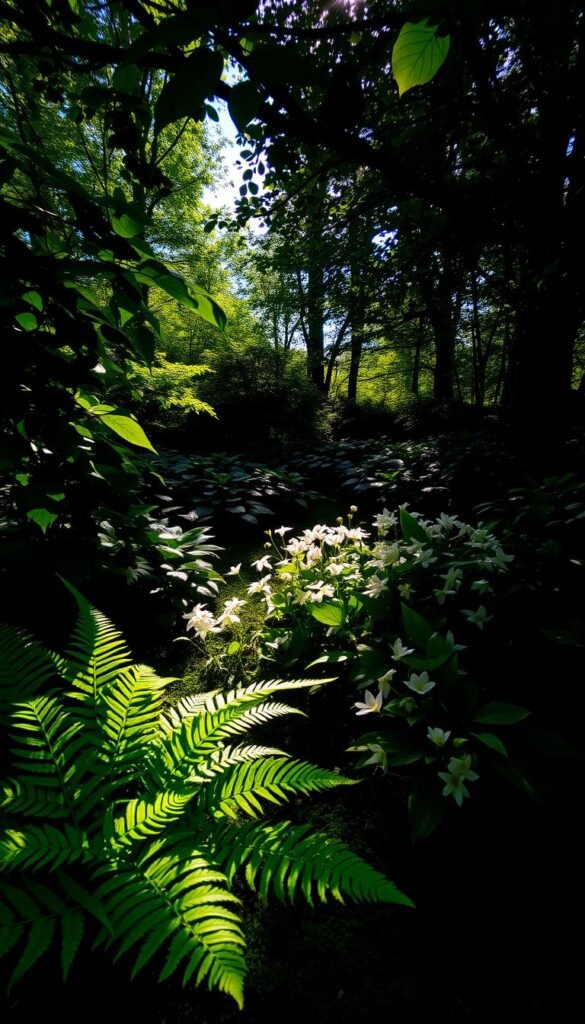
Your garden’s shadows hold secrets waiting to be decoded. Light patterns shift like invisible tides, creating unique growing conditions that determine which plants will succeed. Start by mapping where sunlight lingers and where it barely grazes.
Identifying Partial and Full Shade Areas
Partial shade means 2-4 hours of direct sun, often in morning or late afternoon. These spots work well for plants needing gentle rays. True full shade areas get less than 2 hours of direct light—perfect for species thriving under dense tree canopies.
Assessing Sunlight Exposure in Your Yard
Grab a notebook and track light every 2 hours. Notice how tree leaves filter sun into dappled patterns—a goldilocks zone for many woodland natives. Remember, spring’s bare branches become summer’s leafy roof, changing light availability.
Watch for microclimates too. A north-facing wall stays cooler, while areas near water features hold more moisture. These subtle differences let you match plants to their ideal part of your garden’s light mosaic.
Selecting the Ideal Flowers for Shady Spots
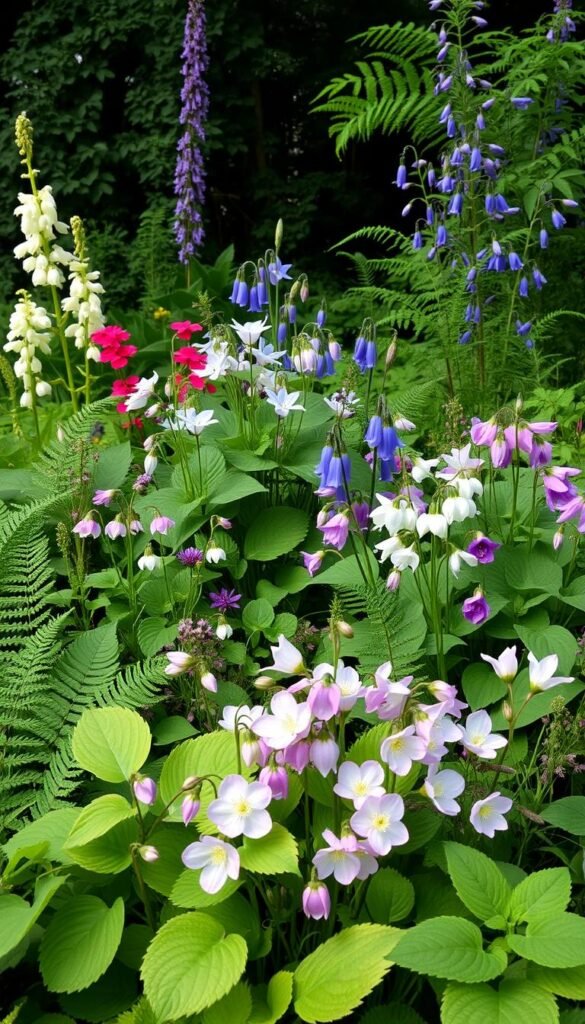
Shaded garden areas don’t have to limit your creativity—they’re opportunities to work with nature’s subtle palette. Focus on species adapted to thrive in filtered light rather than those merely surviving it. This distinction ensures vibrant growth and lasting blooms.
Mix early, mid-, and late-season bloomers to maintain color from spring through fall. Foxgloves tower in early summer, while heuchera adds foliage interest year-round. For container arrangements, explore compact varieties that brighten patios without overwhelming space.
Consider these factors when choosing plants:
- Mature height and spread to prevent overcrowding
- Consistent moisture needs across groupings
- Soil acidity preferences matching your garden’s conditions
Start with natural performers like astilbe and bleeding heart. Their proven resilience lets you build confidence before trying exotic species. Remember: successful shade gardens balance bold experimentation with strategic planning.
Exploring Wild Flower Varieties That Flourish in Shade
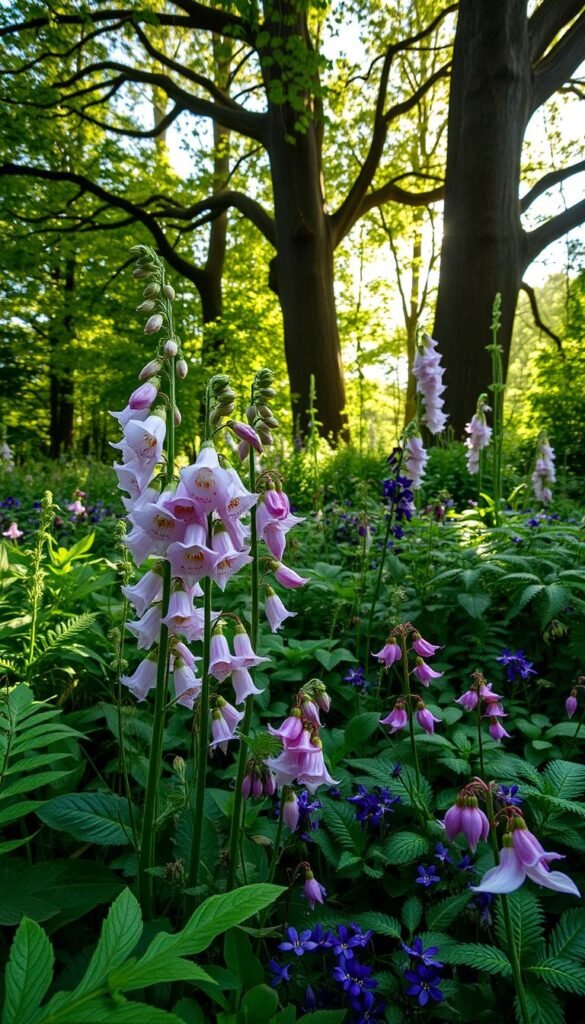
Your shaded garden isn’t a limitation—it’s a stage for nature’s underappreciated performers. From fleeting spring stars to summer-long bloomers, these plants reveal hidden dimensions of beauty in filtered light. Let’s explore options that transform dim corners into dynamic displays.
Perennial Favorites That Bring Year-Round Charm
Virginia bluebells steal the spring show with buds that blush pink before bursting into sky-blue clusters. These ephemeral beauties vanish by midsummer, making room for later bloomers. Pair them with foamflower for contrasting textures—their fuzzy stems and star-shaped flowers create lasting interest.
Annual Options for Instant Color
Snapdragons thrive under deciduous trees, their dragon-shaped blooms reaching toward dappled light. While foxgloves take two years to flower, their towering spikes deliver drama once established. Caution: These biennials contain toxins harmful if ingested.
Violet family members offer edible petals and extended bloom times. Pansies wink with cheerful faces in spring, while violas often rebloom in cooler fall weather. Mix these with shade-tolerant impatiens for nonstop color through multiple seasons.
Caring for Shade-Loving Flowers: Tips and Tricks
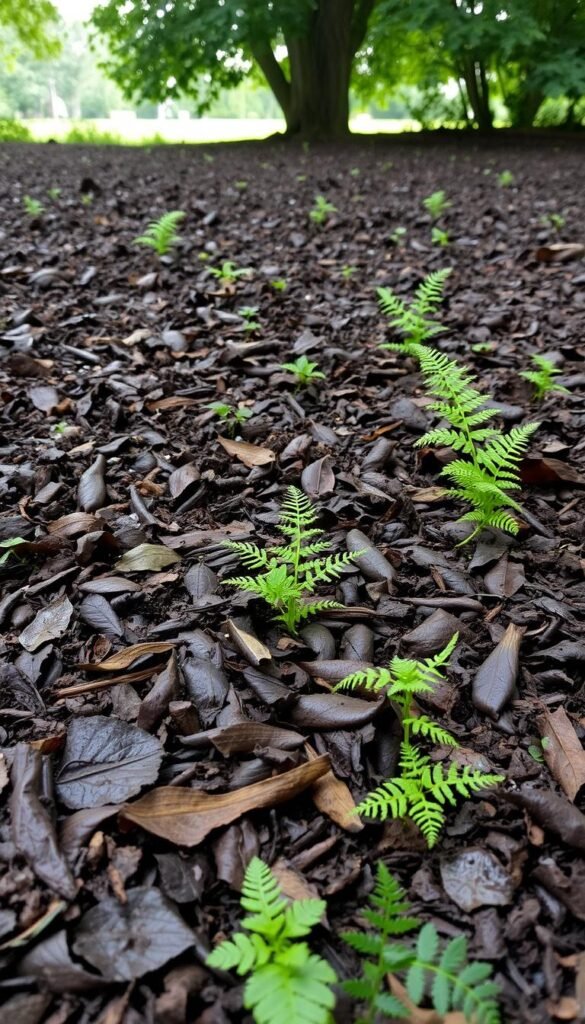
Dark corners become vibrant showstoppers when you master these care essentials. Success with woodland species starts below ground—their roots crave conditions mirroring forest floors.
Watering and Soil Considerations
Your plants need rich organic soil that acts like a sponge—holding moisture without drowning roots. Mix compost into clay or sandy earth to create this balance. Water deeply during spring growth, then ease off in winter to avoid soggy conditions that invite rot.
Maintenance Made Simple
Spread shredded bark or leaf mulch around stems. This blanket keeps roots cool, locks in moisture, and smothers weeds. Refresh it annually as it breaks down into nutrient-rich humus.
Well-drained soil matters as much as water retention. If puddles linger after rain, build raised beds or mix in perlite. Your green companions will reward you with vigorous growth when their feet stay moist but never wet.
Landscape Planning for Low-Light Gardens
Transform shadowy spaces into living art with smart layout strategies. Begin by sketching your yard’s light patterns using simple symbols—circles for deep shade, stripes for dappled light. Track changes through morning and afternoon over a week to spot seasonal shifts.
Space becomes your secret weapon. Allow room for plants to reach mature widths without crowding neighbors. A hosta that starts small can spread three feet wide in two years—plan accordingly to prevent root competition.
Build depth by layering heights. Place feathery ferns at eye level behind low-growing sweet woodruff. This creates natural-looking tiers that guide the gaze through your garden. Remember: tallest specimens belong near fences or walls to maximize visibility.
Group moisture-loving species together near downspouts or natural drainage areas. Dry-tolerant varieties like epimedium thrive farther from water sources. This zoning cuts maintenance time and keeps roots happy.
Add winding stone paths between planting beds to invite exploration. A weathered bench under a tree turns forgotten corners into reading nooks. These touches make your shaded oasis feel intentional rather than accidental.
Enhancing Texture with Foliage and Groundcovers
Your shaded spaces transform into living mosaics when you play with leaf diversity. Foliage becomes the star performer where flowers take breaks, offering year-round visual drama through shape and pattern variations.
Mastering Leaf Variety
Siberian bugloss anchors your design with dinner-plate-sized heart-shaped leaves. Its silver-veined foliage catches faint light like nature’s reflector panels. Pair it with foamflower’s burgundy-striped leaves for a striking contrast that deepens as temperatures drop.
Lungwort works magic in shadowy corners. Its dark green leaves dotted with silver polka dots brighten spaces where blooms fade. Combine different textures—glossy hellebore leaves beside fuzzy lamium creates tactile intrigue that invites touch.
Groundcovers like ajuga weave through taller plants with colorful leaves. Their purple-bronze hues complement neighboring greens while suppressing weeds. You’ll create layered interest without overcrowding—each plant’s unique form gets room to shine.
Shade-Loving Flowers for Your Wild Flower Garden: Thriving in Low-Light Areas
Unlock the hidden potential of your garden’s shadowy nooks with wildflowers built for dim environments. Two stars rise above the rest—astilbe and foamflower. These low-light specialists deliver layered beauty through foliage and blooms, thriving where other plants falter.
Astilbe’s fern-like leaves create lush foundations even before flowering begins. Some varieties feature marbled patterns or variegated edges, adding intrigue when not in bloom. Come summer, their feathery plumes erupt in shades from cotton-candy pink to deep raspberry.
Foamflower steals hearts with heart-shaped leaves etched in burgundy veins. Unlike many full shade plants, it blooms generously—delicate white spikes resembling sea foam appear in spring. As temperatures drop, foliage transforms into copper-toned masterpieces.
Why choose these species?
- Three-season appeal: Spring blooms, summer texture, fall color shifts
- Natural pest resistance evolved in woodland habitats
- Minimal maintenance once established in moist soil
These plants excel because they’re not fighting their environment. Their DNA whispers forest-floor wisdom, making them perfect partners for shaded beds. Pair them with other native shade wildflowers to build resilient, self-sustaining displays.
Your garden’s dimmest corners will pulse with life as these blooms emerge. They don’t just survive—they create ecosystems where every leaf and petal tells a story of adaptation.
Seasonal Bloom Guide for Low-Light Gardens
Timing is everything when curating blooms for shaded spaces. Nature’s calendar offers staggered beauty if you know which performers take the stage each quarter. Let’s explore how to maintain vibrant displays from melting snow to first frost.
Spring’s Fleeting Magic
Virginia bluebells emerge as winter retreats, carpeting the ground with sky-blue clusters. Their reddish stems support blooms that fade as trees leaf out. Pair them with foamflower to extend the show—its airy white blossoms linger through late spring.
Summer’s Resilient Stars
Astilbe becomes the spotlight-stealer when heat rises. Feathery plumes in raspberry or cream appear in early summer, lasting 8–10 weeks. Pro tip: Combine with wishbone flowers for nonstop color—their purple-and-yellow blooms thrive until autumn’s chill.
“A well-planned shade garden dances through seasons like a symphony—each plant playing its part at the perfect moment.”
| Season | Plant | Bloom Time | Key Features |
|---|---|---|---|
| Early Spring | Virginia Bluebell | 3–4 weeks | Ephemeral blue clusters |
| Late Spring | Foamflower | 6 weeks | Frothy white-pink blooms |
| Early Summer | Astilbe | 8–10 weeks | Feathery plumes |
| Summer-Fall | Wishbone Flower | Until frost | Continuous purple/yellow |
| Winter | Hellebore | Dec–Mar | Evergreen foliage |
For fall texture, hellebores unfurl burgundy-veined leaves while cold-hardy ferns add structure. Discover more ideas through our seasonal container arrangements guide to amplify your shaded spaces year-round.
Arranging Your Garden: Design Ideas for Shaded Areas
Turn overlooked spaces into captivating displays through strategic plant placement. Your shaded areas become design opportunities when you play with vertical layers and intentional color pairings. Tall foxgloves with bell-shaped blooms create living pillars, while cascading lobelia spills over edges like nature’s confetti.
Layering Heights and Colors for Visual Interest
Start by anchoring your design with towering specimens. Delphiniums shoot up five-foot spires dotted with sapphire blossoms, creating instant drama. Mid-height astilbe adds feathery texture at eye level, its pink plumes glowing in filtered light.
Use pale yellows and crisp whites to brighten dim corners. These hues reflect available light, making spaces feel airy. Contrast them with deep burgundy heucheras—their rich leaves add sophistication. Repeat key plants along pathways to guide the eye smoothly through your garden.
Vary growth habits for dynamic movement. Upright snakeroot stands sentry-like beside arching ferns. This mix of forms keeps your shaded beds lively yet balanced. Remember: successful layering combines different heights and textures without overcrowding.

